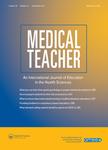版权所有:内蒙古大学图书馆 技术提供:维普资讯• 智图
内蒙古自治区呼和浩特市赛罕区大学西街235号 邮编: 010021

作者机构:Univ Queensland Ctr Med Educ Res & Scholarship Herston Qld 4006 Australia Univ Queensland Sch Med Herston Qld 4006 Australia Flinders Univ S Australia Adelaide SA Australia Univ Queensland Fac Engn Architecture & Informat Technol Herston Qld 4006 Australia Univ Queensland Rural Clin Sch Herston Qld 4006 Australia
出 版 物:《MEDICAL TEACHER》 (医学教师)
年 卷 期:2013年第35卷第8期
页 面:E1340-E1364页
核心收录:
学科分类:12[管理学] 1204[管理学-公共管理] 0401[教育学-教育学] 120402[管理学-社会医学与卫生事业管理(可授管理学、医学学位)] 1004[医学-公共卫生与预防医学(可授医学、理学学位)] 10[医学]
主 题:MEDICINE -- Study & teaching CINAHL (Information retrieval system) CLINICAL medicine HEALTH occupations students INFORMATION storage & retrieval systems -- Medicine INTERNSHIP programs LONGITUDINAL method MEDICAL personnel & patient MEDLINE ONLINE information services SCHOOL environment SYSTEMATIC reviews (Medical research) INTER-observer reliability PATIENT-centered care MEDICAL coding SOCIETIES, etc.
摘 要:Background: Traditionally, clinical learning for medical students consists of short-term and opportunistic encounters with primarily acute-care patients, supervised by an array of clinician preceptors. In response to educational concerns, some medical schools have developed longitudinal placements rather than short-term rotations. Many of these longitudinal placements are also integrated across the core clinical disciplines, are commonly termed longitudinal integrated clerkships (LICs) and often situated in rural locations. This review aimed to explore, analyse and synthesise evidence relating to the effectiveness of longitudinal placements, for medical students in particular to determine which aspects are most critical to successful outcomes. Method: Extensive search of the literature resulted in 1679 papers and abstracts being considered, with 53 papers ultimately being included for review. The review group coded these 53 papers according to standard BEME review guidelines. Specific information extracted included: data relating to effectiveness, the location of the study, number of students involved, format, length and description of placement, the learning outcomes, research design, the impact level for evaluation and the main evaluation methods and findings. We applied a realist approach to consider what works well for whom and under what circumstances. Findings: The early LICs were all community-based immersion programs, situated in general practice and predominantly in rural settings. More recent LIC innovations were situated in tertiary-level specialist ambulatory care in urban settings. Not all placements were integrated across medical disciplines but were longitudinal in relation to location, patient base and/or supervision. Twenty-four papers focussed on one of four programs from different viewpoints. Most evaluations were student opinion (survey, interview, focus group) and/or student assessment results. Placements varied from one half day per week for si